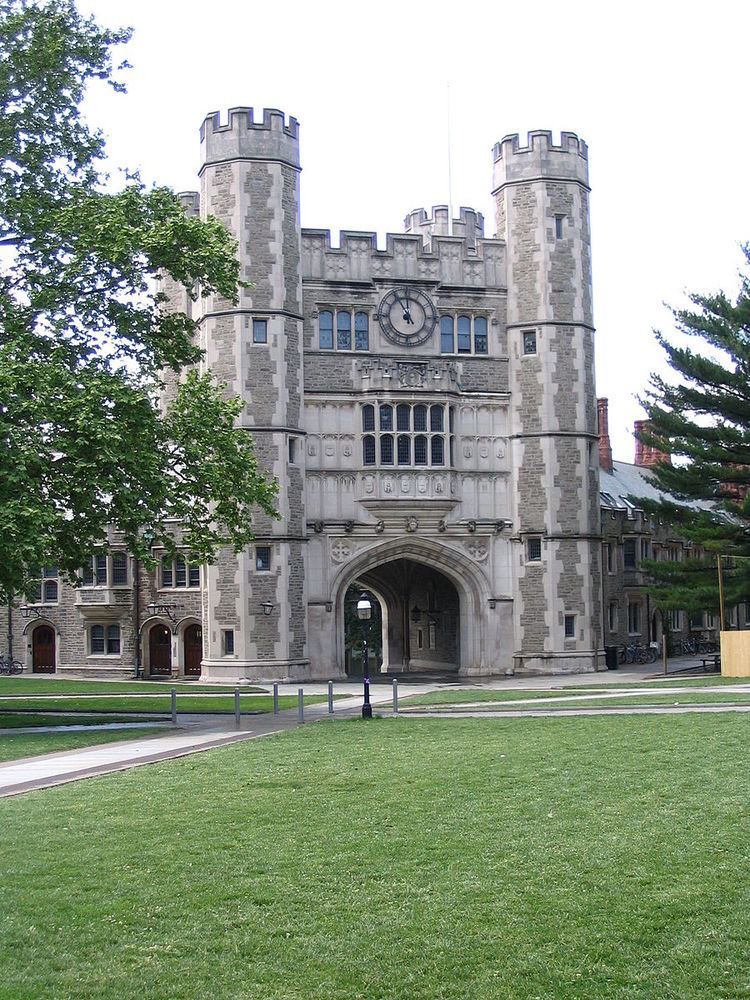 | ||
Collegiate Gothic was an architectural style subgenre of Gothic Revival architecture, popular in the late-19th and early-20th centuries for college and high school buildings in the United States and Canada, and to a certain extent Europe. A form of historicist architecture, it took its inspiration from English Tudor and Gothic buildings.
Contents
Ralph Adams Cram, arguably the leading Gothic Revival architect and theoretician in the early 20th Century, stated the appeal of the Gothic for educational facilities in his book Gothic Quest as, "Through architecture and its allied arts we have the power to bend men and sway them as few have who depended on the spoken word. It is for us, as part of our duty as our highest privilege to act . . . for spreading what is true."
Beginnings
Gothic Revival architecture was used for American college buildings as early as 1829, when "Old Kenyon" was completed on the campus of Kenyon College in Gambier, Ohio. Alexander Jackson Davis's University Hall (1833–37, demolished 1890), on New York University's Washington Square campus, was another early example. Richard Bond's church-like library for Harvard College, Gore Hall (1837–41, demolished 1913), became the model for other library buildings. James Renwick, Jr.'s Free Academy Building (1847–49, demolished 1928), for what is today City College of New York, continued in the style. Inspired by London's Hampton Court Palace, Swedish-born Charles Ulricson designed Old Main (1856–57) at Knox College in Galesburg, Illinois.
Following the Civil War, idiosyncratic High Victorian Gothic buildings were added to the campuses of American colleges, including Yale College – Farnam Hall (1869–70), Russell Sturgis, architect; the University of Pennsylvania – College Hall (1870–72), Thomas W. Richards, architect; Harvard College – Memorial Hall, (1870–77), William Robert Ware and Henry Van Brunt, architects; and Cornell University – Sage Hall (1871–75), Charles Babcock, architect. In 1871, English architect William Burges designed a row of vigorous French Gothic-inspired buildings for Trinity College – Seabury Hall, Northam Tower, Jarvis Hall (all completed 1878) – in Hartford, Connecticut.
Tastes became more conservative in the 1880s, and "collegiate architecture soon after came to prefer a more scholarly and less restless Gothic."
Movement
Beginning in the late-1880s, Philadelphia architects Walter Cope and John Stewardson expanded the campus of Bryn Mawr College in an understated English Gothic style that was highly sensitive to site and materials. Inspired by the architecture of Oxford and Cambridge universities, and historicists but not literal copyists, Cope & Stewardson were highly influential in establishing the Collegiate Gothic style. Commissions followed for collections of buildings at the University of Pennsylvania (1895-1911), Princeton University (1896-1902), and Washington University in St. Louis (1899-1909), marking the nascent beginnings of a movement that transformed many college campuses across the country.
In 1901, the firm of Shepley, Rutan & Coolidge created a master plan for a Collegiate Gothic campus for the fledgling University of Chicago, then spent the next 15 years completing it. Some of their works, such as the Mitchell Tower (1901–08), were near-literal copies of historic buildings.
George Browne Post designed the City College of New York's new campus (1903–07) at Hamilton Heights, Manhattan, in the style.
The style was experienced up-close by a wide audience at the 1904 Louisiana Purchase Exposition in St. Louis, Missouri. The World's Fair and 1904 Olympic Games were held on the newly completed campus of Washington University, which delayed occupying its buildings until 1905.
The movement gained further momentum when Charles Donagh Maginnis designed Gasson Hall at Boston College in 1908. Maginnis & Walsh went on to design Collegiate Gothic buildings at some twenty-five other campuses, including the main buildings at Emmanuel College (Massachusetts), and the law school at the University of Notre Dame.
Ralph Adams Cram designed one of the most poetic collections of Collegiate Gothic buildings for the Princeton University Graduate College (1911–17).
James Gamble Rogers's extensive work at Yale University, beginning in 1917, took historicist fantasy to an extreme. He was criticized by the growing Modernist movement. His cathedral-like Sterling Memorial Library (1927–30), with its ecclesiastical imagery and lavish use of ornament, came under vocal attack from one of Yale's own undergraduates:
"A modern building constructed for purely modern needs has no excuse for going off in an orgy of meretricious medievalism and stale iconography."
Following McMaster University's decision to relocate to Hamilton, Ontario, Canadian architect William Lyon Somerville designed its new campus (1928–30) in the style.
The first occurrence of the term "Collegiate Gothic" in literature was made by architect Charles Klauder in his book College Architecture in America (1929): "The architectural vicissitudes through which the separate units or colleges on the Don and Cam have passed, such as the addition of stories, the completion of quads, the addition of wall dormers and the like, only confirm the claim of adaptability and elasticity for this, the Collegiate Gothic style."
Hybrids
Collegiate Gothic complexes were most often horizontal compositions, save for a single tower or towers serving as an exclamation.
At the University of Pittsburgh, Klauder was presented with a limited site and opted for verticality. The Cathedral of Learning (1926–37), a steel-frame, limestone-clad, 42-story skyscraper, is the world's second tallest university building and second tallest Gothic-styled building. It has been described as the literal culmination of late Gothic Revival architecture. The tower contain a half-acre Gothic hall whose mass is supported only by its 52-foot (16 m) tall arches. It is accompanied by the campus's other Gothic Revival structures by Klauder, including the Stephen Foster Memorial (1935–37) and the French Gothic Heinz Memorial Chapel (1933–38).
